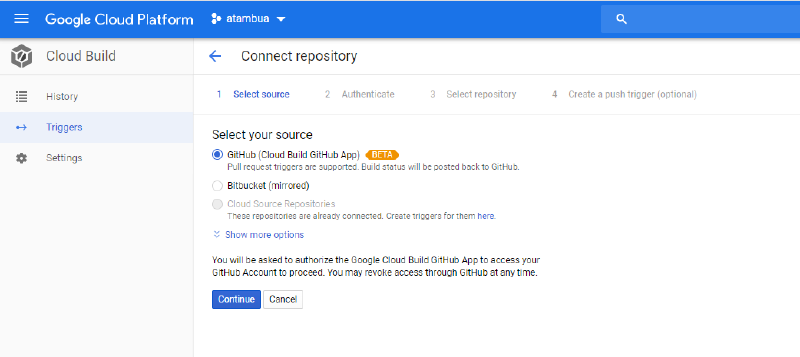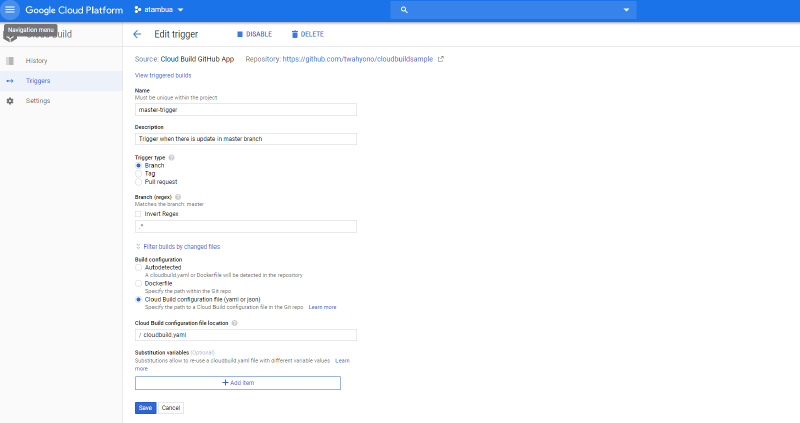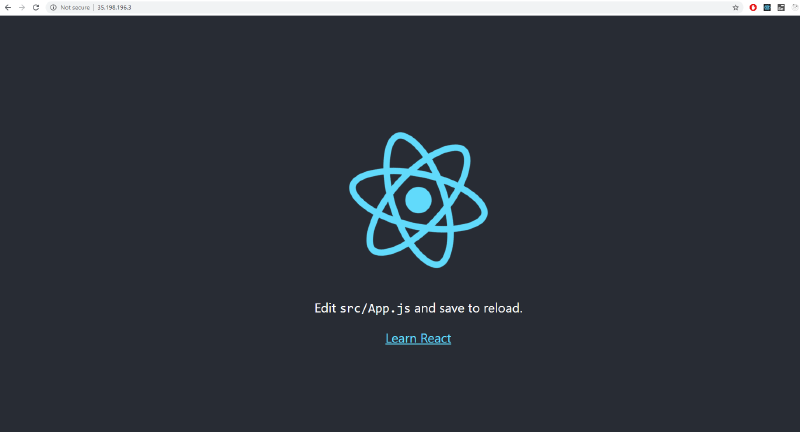Cloud Build Series #1: Automatic deployment to Google Kubernetes Engine with Cloud Build
By twahyono
Prerequisites
- You have Google Cloud account login
- You have Google Cloud SDK installed locally
- Enable billing for your project
- You must activate Kubernetes Engine API, Cloud Build API, Repository API
- Sample project provided at sample
Goal
You want to make automatic deployment whenever the developer push some new commit in the application source code repository.
Creating New Kubernetes Cluster
Create new cluster with f1-micro machine type. For this trial purpose we will use preemptible machine to keep the cost down. Preemptible means we are using spare capacity available from GCP to create node. This node will be restart by Google every 24 hours.
Create new project in GCP and configure default zone
$ gcloud projects create atambua
$ gcloud config set project atambua
$ gcloud config set compute/zone asia-southeast1-a
$ gcloud config list
[compute]
region = asia-southeast1
zone = asia-southeast1-a
[core]
account = your@email.co.id
disable_usage_reporting = True
project = atambua
Check available machine type in your zone
$ gcloud compute machine-types list --filter=zone=asia-southeast1-a
Create new Kubernetes cluster
$ gcloud container clusters create my-cluster --machine-type=f1-micro --preemptible --zone=asia-southeast1-a
Verify that nodes are being created.
$ kubectl get nodes
NAME STATUS ROLES AGE VERSION
gke-my-cluster-default-pool-8d0c1fcb-gc08 Ready <none> 19s v1.13.11-gke.14
gke-my-cluster-default-pool-8d0c1fcb-hjjh Ready <none> 18s v1.13.11-gke.14
gke-my-cluster-default-pool-8d0c1fcb-n9b8 Ready <none> 20s v1.13.11-gke.14
Creating Google Cloud Build trigger for automatic deployment
- Go to Google Cloud Build and choose to create new trigger
- Connect your source repository either in Github or Google Repository to cloud build trigger
- Edit your trigger configuration and create cloudbuild.yaml file



Preparing cloudbuild.yaml file
- Create your own cloudbuild.yaml file (sample available in the Github)
- To learn the basic of cloud build configuration open here
Make sure you already set all default config to proper value to ensure Google Cloud Build step will not failed. Set your cluster to [cluster-name]
$ gcloud config set container/cluster my-cluster
Create cloudbuild.yaml file and put in the the root directory of your project. Cloud Build will running code inside this file whenever you push new commit in the repo and automatically deploy application in the Kubernetes Engine.
cloudbuild.yaml file content:
steps:
- id: 'build image'
name: 'gcr.io/cloud-builders/docker'
args:
- 'build'
- '-t'
- 'gcr.io/${PROJECT_ID}/myreact-app:$SHORT_SHA'
- '.'
- '-f'
- './Dockerfile'
timeout: 1000s
- id: 'push to container registry'
name: 'gcr.io/cloud-builders/docker'
args:
- 'push'
- 'gcr.io/${PROJECT_ID}/myreact-app:$SHORT_SHA'
- id: 'deploy to gke'
name: 'gcr.io/cloud-builders/gcloud'
env:
- 'CLOUDSDK_COMPUTE_ZONE=${_CLOUDSDK_COMPUTE_ZONE}'
- 'CLOUDSDK_CONTAINER_CLUSTER=${_CLOUDSDK_CONTAINER_CLUSTER}'
- 'KUBECONFIG=/.kube/config'
entrypoint: 'bash'
args:
- '-c'
- |
gcloud container clusters get-credentials your-k8s-cluster-name --project your-project-id --zone your-compute-zone
sed -i 's|gcr.io/project-id/myreact-app|gcr.io/$PROJECT_ID/myreact-app:$SHORT_SHA|' ./deployment.yaml
kubectl apply -f ./deployment.yaml
timeout: 2000s
Create your Kubernetes deployment
This file will be apply in the cloud builder step id “deploy to gke”. File deployment.yaml will contains Kubernetes instruction to deploy container image to Kubernetes cluster:
apiVersion: extensions/v1beta1
kind: Deployment
metadata:
labels:
app: myreact-app
name: myreact-app
spec:
replicas: 1
selector:
matchLabels:
app: myreact-app
strategy:
rollingUpdate:
maxSurge: 1
maxUnavailable: 1
type: RollingUpdate
template:
metadata:
creationTimestamp: null
labels:
app: myreact-app
spec:
containers:
- image: gcr.io/project-id/myreact-app
imagePullPolicy: Always
name: myreact-app
Evaluate the trigger result in Cloud Build history
Check in the cloud build history if the trigger was run successfully into completion.
Verify that pods are running in the cluster
$ kubectl get pods
NAME READY STATUS RESTARTS AGE
myreact-app-d5f85b778-k76dz 1/1 Running 0 26m
Exposing your deployment/pods
Before you can access the pods from outside you need to create Kubernetes service to expose the pods
$ kubectl expose deployment myreact-app --port=80 --target-port=80 --type=LoadBalancer
Verify service creation
$ kubectl get svc
NAME TYPE CLUSTER-IP EXTERNAL-IP PORT(S) AGE
kubernetes ClusterIP 10.3.240.1 <none> 443/TCP 33m
myreact-app LoadBalancer 10.3.241.212 35.198.196.3 80:31119/TCP 21m
Check your application
Try open external ip with your browser, in this case http://35.198.196.3

You successfully deploy application in Kubernetes cluster.